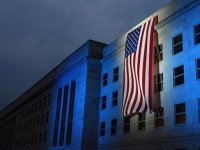How to Help Your Students Observe the 9/11 Anniversary
There are numerous online resources available for teaching about 9/11.
Your content has been saved!
Go to My Saved Content.Whether it's with a moment of silence or an outpouring of service, schools across the country are considering how to help their students observe the anniversary of the 9/11 attacks. A wide range of resources are available to assist educators as they seek learning opportunities around this emotion-charged date.
Build Resilience
Media coverage of the anniversary is certain to be intense, including graphic images of the terror attacks and interviews with survivors. Most of today's students are too young to remember the day the Twin Towers fell, but coverage may nonetheless trigger fear, grief, anxiety, and other strong reactions. The National Association of School Psychologists recommends reinforcing children's natural resilience, and helping them "to see themselves as a positive force in their world, even in the face of adversity." NASP has produced a series of 9/11 discussion guides (in English in Spanish) for teachers and parents.
Explore Artifacts
9/11 Memorial website of the National September 11 Memorial Museum at the World Trade Center, provides information and multimedia resources for understanding the events of 2001. A section of the site specifically for educators suggests that students may be considering difficult questions as the anniversary approaches, such as, "Why would someone do this?" Or, "What does this mean for me?" To help students make their own sense of history, 9/11 Memorial provides access to artifacts. Exploring the collection of the collection of post-9/11 tributes, for example, might inspire new student projects for the 10th anniversary.
Learn through Stories
Learning through stories of personal transformation is the theme of the educational toolkit produced by the World Trade Center Tribute Site. Video portraits introduce eight individuals whose lives were forever changed by 9/11. Ada Dolch, for example, was principal of a high school a block from the World Trade Center. She helped to establish a school in Afghanistan to honor her sister, who was killed in the attacks. The educator toolkit offers information on how students can gather oral histories. It also links to a global collaboration project, "Breaking Stereotypes," hosted by iEARN.
Write to Learn
Rethinking Schools produced an award-winning special report in the aftermath of 9/11 called War, Terrorism and Our Classrooms. The contents continue to offer a rich repository of writing prompts and teaching strategies. For example, an essay by the late naturalist Steven Jay Gould explained a theory he called "the Great Asymmetry," in which "every spectacular incident of evil will be balanced by 10,000 acts of kindness, too often unnoted and invisible as the 'ordinary' efforts of a vast majority." Students might respond to his essay by drawing their own version of what Gould called a "web of bustling goodness," or writing stories that document examples of human compassion in their communities.
Consider How We Remember
A day after the terror attacks, the American Folklife Center marshaled the nation's folklorists to document America's reaction. The outpouring of songs, pictures, and words by Americans of all ages has been catalogued in a collection called the September 11, 2001, Documentary Project, archived by the Library of Congress American Memory project. The collection, available online, could be the springboard for student projects that make use of historical artifacts for inquiry in social studies, writing, art, music, or interdisciplinary studies.
Learn through Service
September 11 has been memorialized as a National Day of Service and Remembrance. Service events to honor the tenth anniversary are taking place in communities across the country, and more than a million Americans are expected to take part in projects ranging from food drives to neighborhood cleanups. United We Serve offers an online search for service opportunities by ZIP code. Toolkits are available to help you plan your own community service project.
Use the News
Exploring how news organization tell the story of 9/11 -- a decade ago or today -- can help students deepen their media literacy skills and learn why the news has been called the first draft of history. Resources to help students think more critically about the news include:
- The Learning Network of The New York Times : Teacher-friendly blog is updated daily with educational resources and lesson ideas based on articles, photos, podcasts, and more materials published in The New York Times. In this post on teaching about 9/11, teachers weigh in with comments about their upcoming classroom plans. Teachers are also encouraged to submit posts about how they use the news for learning.
- Newseum: This media museum based in Washington, DC, offers online resources, such as newspaper front pages from around the world.
- Newspaper Map: This interactive map allows you to find and translate newspapers from 10,000 sites around the world.
- Newsmap: This site shows how world headlines are trending in real time across several categories.
- Media Literacy Skills: Interpreting Tragedy (PDF download): Available for download from the National Council for the Social Studies, this publication by media literacy expert Renee Hobbs explains why it's important for students to think critically and also create their own content in response to events.
Today's students have grown up with social networks that weren't yet invented in 2001. Facebook didn't start until 2004; Twitter didn't launch until 2006. Help your students think about how these platforms have changed the way that information travels. Where do students turn first for information? How do they decide what's "true" when they hear about breaking events? How might they contribute their own stories or photos as citizen journalists?
Share Your Ideas
How will you observe the 10th anniversary with your students? Please share your stories and ideas for learning.
